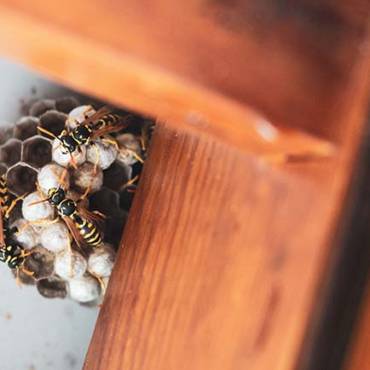Expert Solutions to Safeguard Your Home from Paper Wasp Infestations
Paper wasp infestations can not only be a major nuisance for homeowners in Thornton, CO, and surrounding areas, but they also pose a significant risk of painful stings, especially for those with allergic reactions. While paper wasps are beneficial to the ecosystem as they help in pollination and caterpillar control, their nests located in close proximity to your home can be hazardous. Understanding the behavior, preferences, and preventative measures for paper wasps and enlisting the expertise of Bee Smart Pest Control will equip you with the necessary knowledge and tools to effectively manage infestations and maintain a safe and wasp-free living environment.
Paper wasps are social insects known for building distinctive, open-celled nests made from a mixture of wood fibers and saliva. Common areas for paper wasp nests include eaves, soffits, deck railings, and tree limbs. While typically non-aggressive, these wasps can become defensive if they perceive a threat to their nest, delivering sharp stings that, in some cases, can cause severe allergic reactions. As a homeowner, it is essential to recognize the signs of a paper wasp infestation and take appropriate action to address the issue without putting yourself or your family in harm’s way.
In this in-depth blog post, we will explore various aspects of paper wasp infestations, including identification, habits, prevention methods, and the benefits of relying on professional pest management services like Bee Smart Pest Control. Proper handling of paper wasp infestations can often be the key to reducing the risk of stinging incidents while protecting your property and family from these unwelcome and potentially dangerous guests.
1. Identifying Paper Wasps and Their Nests
Proper identification of paper wasps and their nests is essential for effective management:
– Appearance: Adult paper wasps range from 0.5 to 1.5 inches in length, with slender bodies, long legs, and a narrow waist. They usually have a brownish color with yellow, orange, or red markings.
– Nests: Paper wasp nests are most often found hanging from horizontal surfaces like eaves, tree limbs, and deck railings. Nests are typically open-celled with a honeycomb-like structure made from wood fibers and wasp saliva.
2. Paper Wasp Habits and Preferences
Understanding the behavior and habits of paper wasps can help you implement targeted prevention and control measures:
– Diet and Foraging: Paper wasps feed on nectar for energy but also hunt caterpillars and insects to provide protein for their developing larvae.
– Non-Aggressiveness: Unlike some other wasp species, paper wasps are generally non-aggressive unless their nest or colony is threatened.
– Colony Expansion: Paper wasp colonies may expand during the warm season, leading to an increased potential for new nest construction and infestations.
3. Preventing Paper Wasp Infestations
Implementing preventive strategies can help protect your home from paper wasp infestations:
– Nest Inspection: Regularly inspect your property for signs of newly constructed nests, particularly in areas like eaves, soffits, and deck railings.
– Seal Entry Points: Identify and seal any openings, cracks, or gaps that could allow paper wasps to access indoor areas for nest construction.
– Landscape Maintenance: Trim trees, shrubs, and other vegetation that may provide a suitable location for paper wasp nests, keeping them away from your home’s immediate vicinity.
– Reduce Sweets and Protein Sources: Clean up fallen fruits and spilled food in your yard to avoid attracting paper wasps in search of food.
4. Managing Paper Wasp Infestations
If you discover a paper wasp infestation on your property, follow these tips to address the issue safely and effectively:
– Assess the Risk: If the nest is located far from your home or high-traffic areas, consider leaving it undisturbed, as paper wasps play an essential role in pollination and pest control.
– Wear Protective Clothing: If attempting to remove a nest, wear long sleeves, pants, and protective headgear to minimize the risk of stings.
– Timing Is Key: Early morning or late evening hours, when wasps are least active, are the best times to attempt nest removal.
– Call a Professional: If you feel uncertain about tackling a nest yourself or if the infestation is extensive, contact a professional pest control company like Bee Smart Pest Control for assistance.
5. The Importance of Professional Pest Control Services
Enlisting the help of a professional pest control service like Bee Smart Pest Control ensures the safe and effective management of paper wasp infestations:
– Expert Knowledge: Pest control professionals possess extensive knowledge of paper wasp behavior and effective treatment methods.
– Customized Treatment Plans: A professional service will accurately assess the extent of the infestation and provide tailored, effective solutions.
– Safety First: Professionals are well-equipped to remove nests and address infestations safely, minimizing the risk of stings and allergic reactions.
Conclusion
A proper understanding of paper wasp habits, preferences, and effective management strategies is key to safeguarding your home against these potentially dangerous pests. Rely on Bee Smart Pest Control to provide the guidance and assistance needed to ensure a secure, wasp-free living environment for you and your family. With their professional expertise and commitment to your safety, Bee Smart Pest Control is your trusted partner in the prevention and management of paper wasp infestations, preserving the structural integrity and well-being of your home and loved ones.
If you hire Bee Smart Pest Control for wasp extermination in Colorado, you can safeguard your property and create a safe and comfortable environment for you and your family, free from the threat of stings. With our knowledge and dedication, Bee Smart Pest Control will help you effectively deal with wasp infestations, giving you peace of mind that your home and loved ones are protected from these potentially dangerous pests. Contact us today




